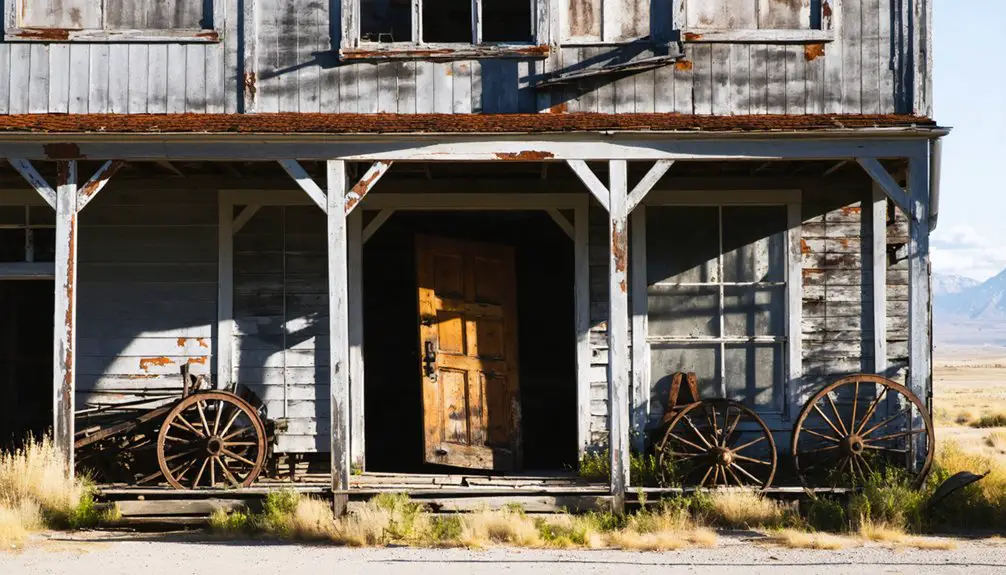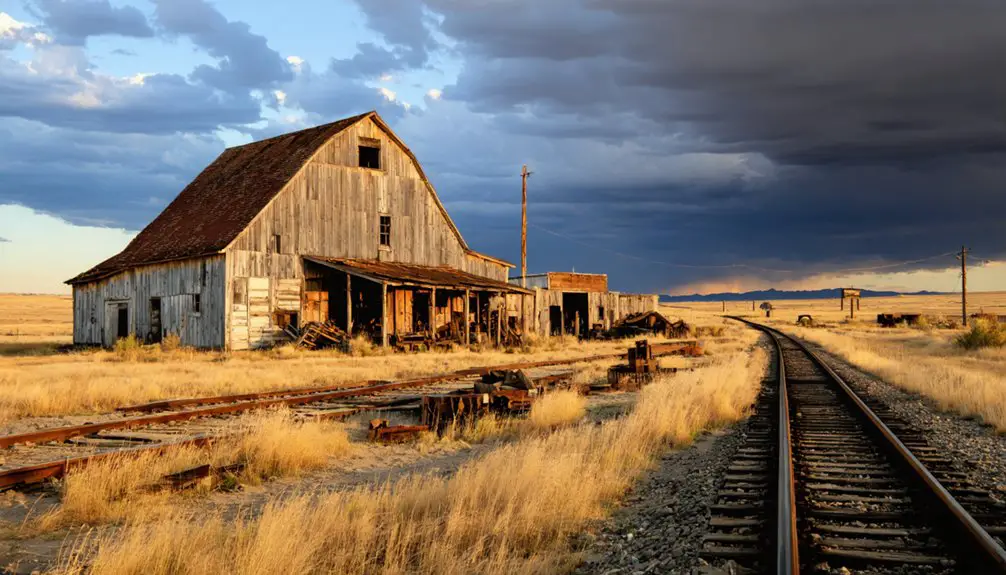You’ll find Hughesville ghost town nestled at 6,000 feet in Montana’s Little Belt Mountains, where silver and lead mining thrived from 1879 to 1943. The site began with Patrick Hughes’s mineral discovery and grew into a bustling community of 1,000 residents with over 15 saloons. Today, you can explore scattered ruins including cabin remnants, mine shafts, and the Clendenin smelter foundations. This remote mountain location holds countless stories of Montana’s mining heritage.
Key Takeaways
- Hughesville was established in 1879 after silver and lead deposits were discovered, becoming one of Montana’s significant mining towns.
- The ghost town sits at 6,000 feet in the Little Belt Mountains, accessible via US Highway 89 from Monarch.
- Remnants include mine shafts, cabin ruins, boiler structures, and the Clendenin smelter foundations from its mining heyday.
- The town peaked with 1,000 residents and 15 saloons before declining, ultimately closing operations in 1943.
- Visitors need 4WD vehicles and should plan trips between spring and fall, as winter conditions make access difficult.
A Mining Town’s Beginning
When Patrick Hughes and E.A. “Buck” Barker discovered silver and lead deposits along Galena Creek in 1879, they established what would become the bustling mining town of Hughesville, Montana.
You’ll find that what started as three separate mining camps – Hughes City, Galena City, and Leadville – quickly merged into one settlement nestled in the rugged Little Belt Mountains of Judith Basin County.
The mining techniques of the era attracted about 100 miners within the first year, drawn by the promise of silver, lead, copper, and zinc deposits.
The community dynamics were shaped by the challenging terrain, leading to a scattered layout of mines and operational buildings.
Early success required hauling ore by wagon to Fort Benton, where it was shipped to Wales for smelting until Colonel G. Clendenin constructed a local smelter in 1881.
The town’s infrastructure expanded to include numerous saloons and a brothel to serve the predominantly male mining population.
Life in the Silver Rush Era
During Montana’s silver rush era of the 1880s and early 1890s, you’d find a bustling economy that ranked second nationally in silver production, trailing only Colorado. The silver mining towns attracted workers from around the globe, creating vibrant communities centered around the industry’s daily operations.
If you’d visited major mining districts like Silver Bow or Deer Lodge County, you’d have witnessed impressive industrial operations processing thousands of tons of ore daily. The Bland-Allison Act spurred tremendous growth in silver mining communities by requiring government silver purchases. Community dynamics revolved around the mines, with towns quickly establishing essential infrastructure including housing, mills, and basic services. Railway transportation made these mining operations profitable by enabling efficient ore distribution across the country.
Life wasn’t easy though – you’d face primitive medical care, frequent accidents, and environmental challenges from mining waste. The boom times brought substantial wealth to some, with mines like those in Philipsburg paying millions in dividends to stockholders during peak production years.
Getting to Hughesville Today
Nestled in the Little Belt Mountains at nearly 6,000 feet elevation, Hughesville awaits visitors who venture off the beaten path in Judith Basin County, Montana.
To reach this historic mining camp, you’ll start in Monarch and head south on US Highway 89. Watch for Hughesville Road, turn east, and continue about 12 miles into the heart of mining country.
Before setting out, you’ll want to check road conditions and weather, as the remote location and mountainous terrain can present challenges. Access routes are rural, and services become scarce once you leave Monarch behind.
While some old buildings and a cemetery remain, remember much of the area is private property. During its peak, the area’s mines and camps supported up to 500 people. You’ll find no interpretive signs here, so research beforehand to make the most of your visit to this authentic piece of Montana’s mining heritage. The site’s elevation of 5994 feet MSL makes it a true mountain mining settlement.
What Remains of the Past
You’ll find scattered ruins across Hughesville’s landscape, including cabin remnants, boiler structures, and smelter foundations that hint at its mining past.
Two original mine shafts stand as prominent industrial relics alongside abandoned ore bins and the partially surviving Clendenin smelter infrastructure.
The scenic mountain views visible from the mine ruins add to the historical atmosphere of this abandoned site.
Though most mining equipment was removed after the 1943 closure, these weathered remains offer a glimpse into the town’s prosperous lead and silver mining era. Hughesville’s proximity to Barker mining camp created a connected network of mineral extraction operations in the area.
Ruins Tell Their Stories
While most of Hughesville’s original structures have succumbed to modern mining operations and natural decay, the remaining ruins paint a vivid picture of this once-thriving mining settlement.
You’ll find scattered foundations and a weathered boiler near the eastern entry points, where the ruins symbolism speaks to the town’s industrial past. The Clendenin Smelter ruins stand as silent sentinels on private land, visible from public areas. The discovery of silver in Galena Creek in 1879 sparked the town’s initial development and rapid growth.
Nature’s reclamation adds depth to the decay narrative, with overgrown vegetation embracing old mining infrastructure across both sides of the rugged access road.
When you explore these mountain ruins, you’ll discover how the site’s transformation from a bustling 500-person community to an abandoned ghost town mirrors Montana’s broader mining history, especially following the Great Depression’s impact.
Mining Equipment Still Stands
Several original mining structures and equipment pieces endure at the Hughesville site, offering glimpses into Montana’s industrial past.
You’ll find two intact mine shafts and scattered remnants of the town’s industrial heritage, though equipment preservation has been minimal due to modern mining operations and natural deterioration.
The historical significance of remaining structures includes:
- The Clendenin Smelter’s visible ruins, showcasing early ore processing methods
- Scattered boiler foundations and bins near the eastern entrance
- Standing miners’ cabins that dot the landscape
- St. Joseph Company mining buildings on private property
While much of the original equipment has been salvaged or destroyed, these remnants tell the story of Hughesville’s role as a major lead and silver producer. Due to acid mine drainage, contaminated red water flows through nearby Galena Creek.
You’ll need an off-road vehicle to access some locations, as many artifacts are spread across rough terrain.
Exploring the Ghost Town

You’ll need a reliable four-wheel drive vehicle to navigate the rugged, overgrown mountain roads leading to Hughesville’s remote location.
The best time to explore the ghost town is from spring through fall, as winter snow makes the already challenging roads nearly impassable.
Your safest approach is from US-89 near Monarch, turning east onto Hughesville Road for approximately 12 miles until you reach the scattered remains of the former mining camp.
Before attempting the journey to Hughesville ghost town, visitors should understand the unique challenges of traversing its remote mountain roads.
You’ll need to navigate unpaved, winding routes through the Little Belt Mountains where weather conditions can change rapidly. While 2WD vehicles might manage during dry seasons, 4WD is recommended for safer passage, especially in spring and fall.
- Download offline maps and bring a GPS device – cell coverage is spotty
- Pack emergency supplies, including water, food, and vehicle repair tools
- Watch for mining remnants and the Clendenin Smelter remains as navigation landmarks
- Plan your visit during summer months when Hughesville Road is most accessible
Remember to inform someone of your travel plans, as emergency services have lengthy response times in this isolated area.
Best Seasons To Visit
When planning your visit to Hughesville ghost town, timing proves essential for both safety and ideal exploration. The seasonal highlights center on spring through fall, with summer offering extensive daylight but larger tourist crowds throughout Montana.
You’ll find spring and fall deliver the most rewarding experiences, featuring moderate temperatures and fewer visitors.
Spring brings emerging wildflowers and wildlife viewing opportunities, though you’ll need to navigate some muddy conditions from snowmelt.
Fall stands out as the premier season, offering vibrant foliage, clear skies, and excellent hiking weather.
Visitor recommendations include avoiding winter entirely, as snow renders the site inaccessible.
Pack appropriate gear for rapid weather changes in the Little Belt Mountains, and consider waterproof boots for spring visits.
Book accommodations well ahead if traveling during peak summer months.
Legacy of a Lost Mining Community
Despite its relatively short lifespan, Hughesville’s legacy endures as a quintessential example of Montana’s boom-and-bust mining era.
You’ll find a story of community resilience in the face of economic fluctuations, from its meteoric rise as Montana’s largest lead producer to its eventual abandonment in 1943.
- The town’s scattered layout, forced by rugged terrain, broke from traditional mining town designs and showcases the pioneers’ adaptability.
- You can explore the remnants of over 15 saloons that once served a bustling population of 1,000 residents.
- The site stands as a symbol of the impact of silver market crashes and technological changes on frontier communities.
- Today’s ruins, including the old cemetery and Clendenin smelter remains, offer you a raw glimpse into Montana’s rich mining heritage.
Frequently Asked Questions
Are There Any Reported Ghost Sightings or Paranormal Activity in Hughesville?
You won’t find documented ghost stories or haunted history at this location. Despite being a ghost town, there aren’t any verified paranormal sightings or supernatural activity in available historical records.
What Wildlife Should Visitors Be Cautious of When Exploring the Area?
You’ll want to keep your wits about you with our furry friends – both black and grizzly bears frequent the area. Stay alert for rattlesnakes, carry bear spray, and watch for mountain lions at dawn and dusk.
Can Metal Detecting or Artifact Collecting Be Done at the Site?
You can’t legally metal detect or collect artifacts here due to private property restrictions and artifact preservation concerns. You’ll need explicit landowner permission, but it’s generally discouraged to protect historical integrity.
Are There Guided Tours or Local Historians Available for Visiting Groups?
You won’t find guided tours or local historians at the site. You’ll need to explore independently, gathering historical insights through your own research before visiting this remote, unpreserved location.
What Are the Closest Emergency Services and Cell Phone Coverage Like?
Prepare properly: You’ll find precarious cell reception and prolonged emergency response times. The nearest clinic’s in Monarch (12 miles west), while serious medical help requires reaching Lewistown, 40 miles southwest. Satellite phones are recommended.
References
- http://berkeleyprize.org/endowment/the-reserve?id=176
- https://www.ghosttowns.com/states/mt/hughesville.html
- https://www.legendsofamerica.com/mt-barkerhughesville/
- https://www.legendsofamerica.com/mt-ghosttowns/
- https://centralmontana.com/listings/sluice-boxes-state-park/
- https://westernmininghistory.com/mine-detail/10008953/
- https://www.mindat.org/loc-27034.html
- https://mhs.mt.gov/education/textbook/chapter6/Chapter6.pdf
- https://en.wikipedia.org/wiki/Montana_silver_mining
- https://cfwep.org/clark-fork-info/history/1860s-gold-silver-and-early-mining/



